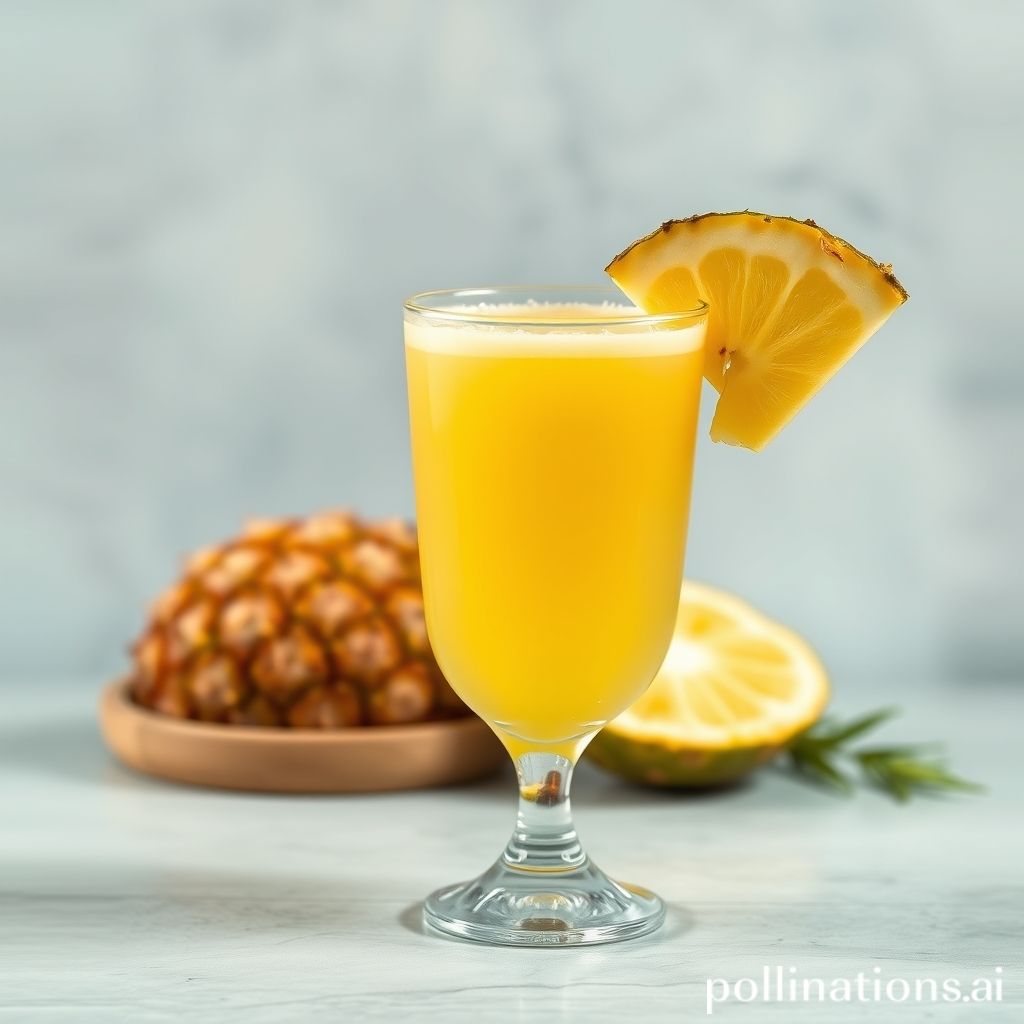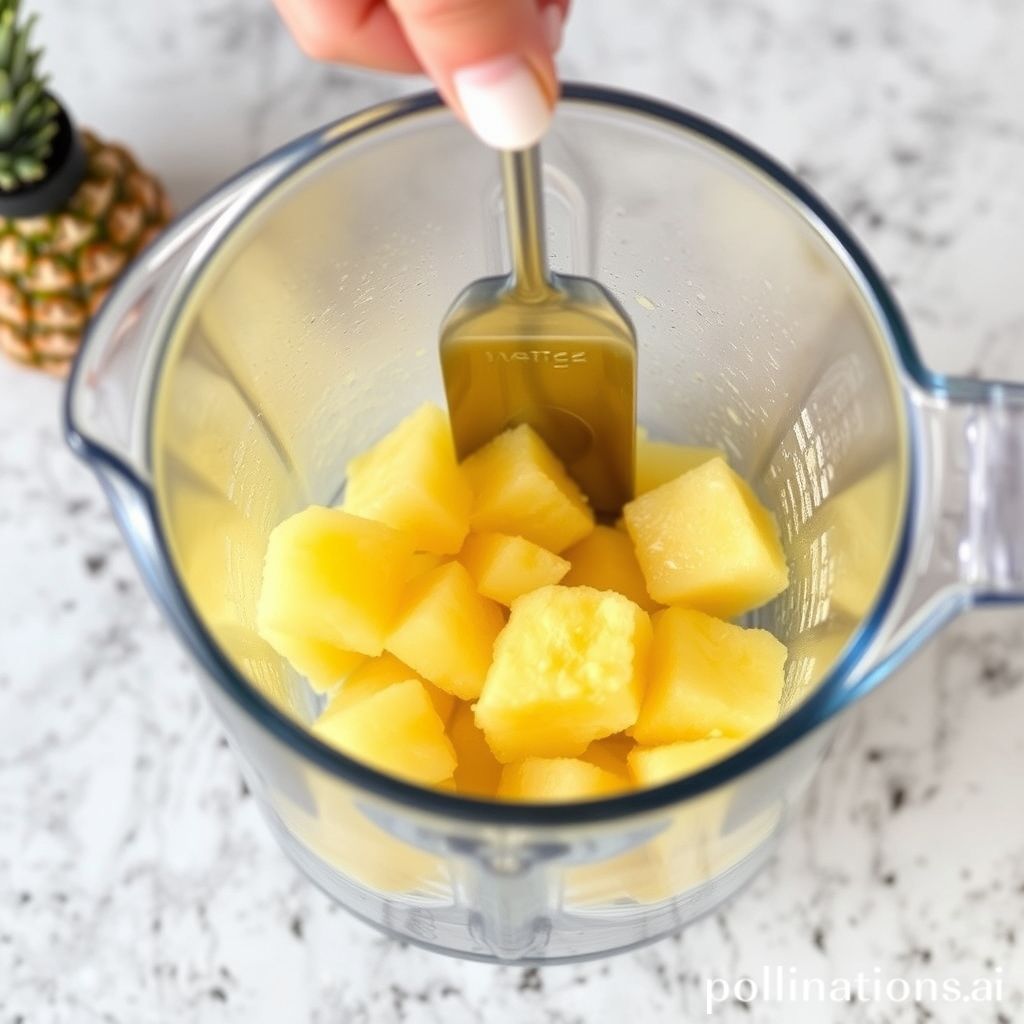Refreshing Homemade Pineapple Juice: Easy Recipe with Step-by-Step Instructions
As for satisfying our thirst and craving for something sweet, pineapple juice is often the go-to choice for many. Whether enjoyed on its own or mixed into tropical cocktails, this refreshing and tangy beverage never fails to deliver a burst of tropical flavor.
Making pineapple juice at home is not only a cost-effective option but also allows you to have complete control over the ingredients. In this article, we will guide you through a simple and easy-to-follow recipe for making pineapple juice. With just a few steps and a handful of ingredients, you can enjoy a glass of freshly squeezed pineapple juice that is bursting with natural goodness. So, let’s get started and quench your thirst with this delightful tropical treat.

Table of Contents
Gathering the Ingredients and Equipment Needed
1. Fresh Pineapples
When making pineapple juice, the first step is to gather fresh pineapples. Look for ripe pineapples as they provide the best flavor and sweetness for your juice. You have the option to buy whole pineapples or pre-cut pineapple chunks, depending on your preference and availability.
2. Water
Water is a crucial ingredient for making pineapple juice. It helps dilute the juice and achieve the desired consistency. You can use tap water or filtered water based on your preference.
3. Sugar (optional)
Adding sugar to your pineapple juice is optional and depends on your taste preferences. If you prefer a sweeter juice, you can add a small amount of sugar to enhance the natural sweetness of the pineapples. Nevertheless, if you prefer a healthier option, you can omit the sugar altogether or use alternative sweeteners like honey or agave syrup.
4. Blender or Juicer
To extract the juice from the pineapples, you will need either a blender or a juicer. You can use a blender if you prefer a thicker and pulpy texture, Whilst a juicer will give you a smoother and clearer juice. Both options are effective in extracting the juice from the pineapples, so choose the method that suits your preference.
Once you have gathered all the necessary ingredients and equipment, you are ready to move on to the next step in making your delicious pineapple juice.
Expert Tips: Choose ripe pineapples for the best flavor. Use filtered water for a cleaner taste. Experiment with alternative sweeteners. Choose a blender for a thicker texture or a juicer for a smoother juice.Preparing the Pineapples
1. Selecting Ripe Pineapples
Choosing the right pineapples is crucial to ensure delicious and flavorful homemade pineapple juice. Follow these steps:
- Look for pineapples that are vibrant yellow in color and have a sweet aroma.
- Avoid pineapples with brown spots, mold, or any signs of damage.
- Check the firmness of the pineapple by gently squeezing it. It should be firm but not too soft.
2. Washing and Peeling the Pineapples
Properly cleaning and peeling the pineapples is essential to remove any dirt or pesticides. Here’s what you need to do:
- Wash the pineapples under running water to remove any surface dirt.
- Using a sharp knife, cut off the top and bottom of the pineapple.
- Stand the pineapple upright and carefully slice off the skin, following the natural curve of the fruit.
- Make sure to remove any remaining “eyes” or brown spots on the pineapple’s flesh.
3. Removing the Core and Cutting the Pineapples into Chunks
Removing the tough core and cutting the pineapples into chunks will make it easier to blend and extract the juice. Here’s how:
- Place the peeled pineapple on a cutting board and cut it in half lengthwise.
- Using a sharp knife, carefully remove the tough core from each pineapple half.
- Cut the pineapple halves into smaller chunks or slices according to your preference.
| Step | Description |
|---|---|
| 1 | Choose ripe pineapples with a vibrant yellow color and a sweet aroma. |
| 2 | Wash the pineapples under running water and peel off the skin. |
| 3 | Remove the tough core and cut the pineapples into chunks. |
Blending Pineapples
1. Adding Pineapple Chunks to the Blender
To make pineapple juice, start by preparing the pineapples. Peel off the skin and remove the core, then cut the pineapples into small chunks for easier blending. Ensure that the pineapples are ripe for the best flavor.
Tip: Choose a pineapple with a sweet aroma and slightly yielding base when pressed.
2. Blending Pineapples Until Smooth
Once you have the pineapple chunks ready, transfer them to a high-powered blender capable of blending fibrous fruits like pineapple.
Tip: For a thinner consistency, you can add a small amount of water or pineapple juice to the blender.
Blend the pineapples on high speed until they reach a smooth and creamy texture. This typically takes 1-2 minutes, depending on the blender’s power.
Tip: For a slightly textured pineapple juice, blend for a shorter time to leave some small pineapple pieces.
Once the pineapples are blended to your desired consistency, stop the blender and taste the juice. Add a small amount of sweetener, such as honey or sugar, if desired.
That’s it! You have successfully blended the pineapples to create delicious and refreshing pineapple juice. Pour the juice into a glass, chill it, and savor the tropical goodness!

How to Strain Pineapple Juice
Step 1: Prepare a Strainer or Cheesecloth
In order to strain the pineapple juice, you will need a strainer or cheesecloth. It is recommended to use a strainer with fine mesh or a double layer of cheesecloth for optimal results. Place the strainer or cheesecloth over a bowl or jug to collect the juice.
Step 2: Pour the Blended Pineapple Mixture
Once you have blended the pineapple to a smooth consistency, carefully pour the mixture into the strainer or cheesecloth. Ensure that the bowl or jug is positioned to catch the juice as it passes through.
Step 3: Extract the Juice from the Pulp
To extract all the juice from the pineapple pulp, press down firmly on the pulp using the back of a spoon or a spatula. Continue pressing until no more juice can be extracted. This will ensure that you obtain the maximum amount of juice from your pineapple.
It is important to remember that straining the pineapple juice helps remove any remaining fibrous bits and results in a smooth and refreshing beverage. This step is essential in the pineapple juice-making process.
| Key Points |
|---|
| Straining the pineapple juice helps remove fibrous bits, resulting in a smooth beverage. |
| For best results, use a fine mesh strainer or double layer of cheesecloth. |
| Ensure to press down firmly on the pulp to extract all the juice. |
Sweetening Pineapple Juice
Taste Testing the Juice
Before adding any sweetener to your pineapple juice, it’s important to taste it first to determine how sweet it is naturally. This will help you gauge how much additional sweetener you may need. Take a small sip of the juice and evaluate its flavor. Note whether it already has a pleasant level of sweetness or if it needs more.
Adding Sugar and Stirring
If you find that your pineapple juice needs a little more sweetness, you can add sugar to enhance the taste. Start by adding a small amount, like a teaspoon, and stir well until the sugar completely dissolves. Taste the juice again to see if it has reached the desired level of sweetness. Repeat this process until you achieve the sweetness you want, making sure not to overpower the natural flavors of the pineapple with too much sugar.
Storing and Serving Pineapple Juice
Once you have sweetened your pineapple juice to perfection, it’s time to think about how to store and serve it.
Refrigerating the Juice
To keep your pineapple juice fresh and flavorful, transfer it into a sealed container and refrigerate it. This will help maintain its taste and prevent spoilage. Use an airtight container or a glass bottle with a tight-fitting lid to store the juice. Don’t forget to label the container with the date to keep track of its freshness.
Serving Pineapple Juice
In regard to serving your pineapple juice, you have a couple of options. You can serve it chilled directly from the refrigerator for a refreshing choice. Alternatively, you can pour the pineapple juice over ice for an extra cooling effect. Both options are delightful, so choose the one that suits your preferences and enjoy!
Conclusion
Making pineapple juice at home is a straightforward process that requires minimal effort. By embracing a step-by-step recipe, you can enjoy a refreshing glass of homemade pineapple juice in no time.
The key ingredients, including fresh pineapple, water, and a sweetener of your choice, combine to create a delicious and healthy beverage. Experimenting with different variations, such as adding mint or ginger, can add a delightful twist to your pineapple juice. With this simple method, you can satisfy your craving for a tropical drink In the course of avoiding the additives and preservatives often found in store-bought options.
Faq about How to Make Pineapple Juice
FAQ 1: Can I use canned pineapple instead of fresh pineapples?
Yes, you can use canned pineapple instead of fresh pineapples to make pineapple juice. Simply drain the juice from the canned pineapple and blend it with water or ice for a refreshing drink.
FAQ 2: How long can I store homemade pineapple juice?
Homemade pineapple juice can be stored in the refrigerator for up to 3-4 days. It is recommended to store it in an airtight container to maintain its freshness and flavor.
FAQ 3: Can I use a juicer instead of a blender?
Yes, you can use a juicer instead of a blender to make pineapple juice. A juicer extracts the juice from the pineapple Meanwhile leaving behind the pulp, resulting in a smoother consistency.
FAQ 4: Can I make pineapple juice without straining it?
Yes, you can make pineapple juice without straining it. If you prefer a thicker juice with pulp, simply blend the pineapple pieces with water or ice until smooth and enjoy the natural texture.
FAQ 5: Can I add other fruits to the pineapple juice for variation?
Absolutely! You can add other fruits to the pineapple juice for a delicious variation. Some popular choices include oranges, strawberries, or mangoes. Simply combine the fruits in a blender or juicer to create a delightful blend of flavors.
Read Similar Post:
1. Maximize Weight Loss Benefits: Optimal Times to Drink Pineapple & Cucumber Juice
2. Pineapple-Infused Mimosa: Elevate Your Brunch with This Tropical Twist

